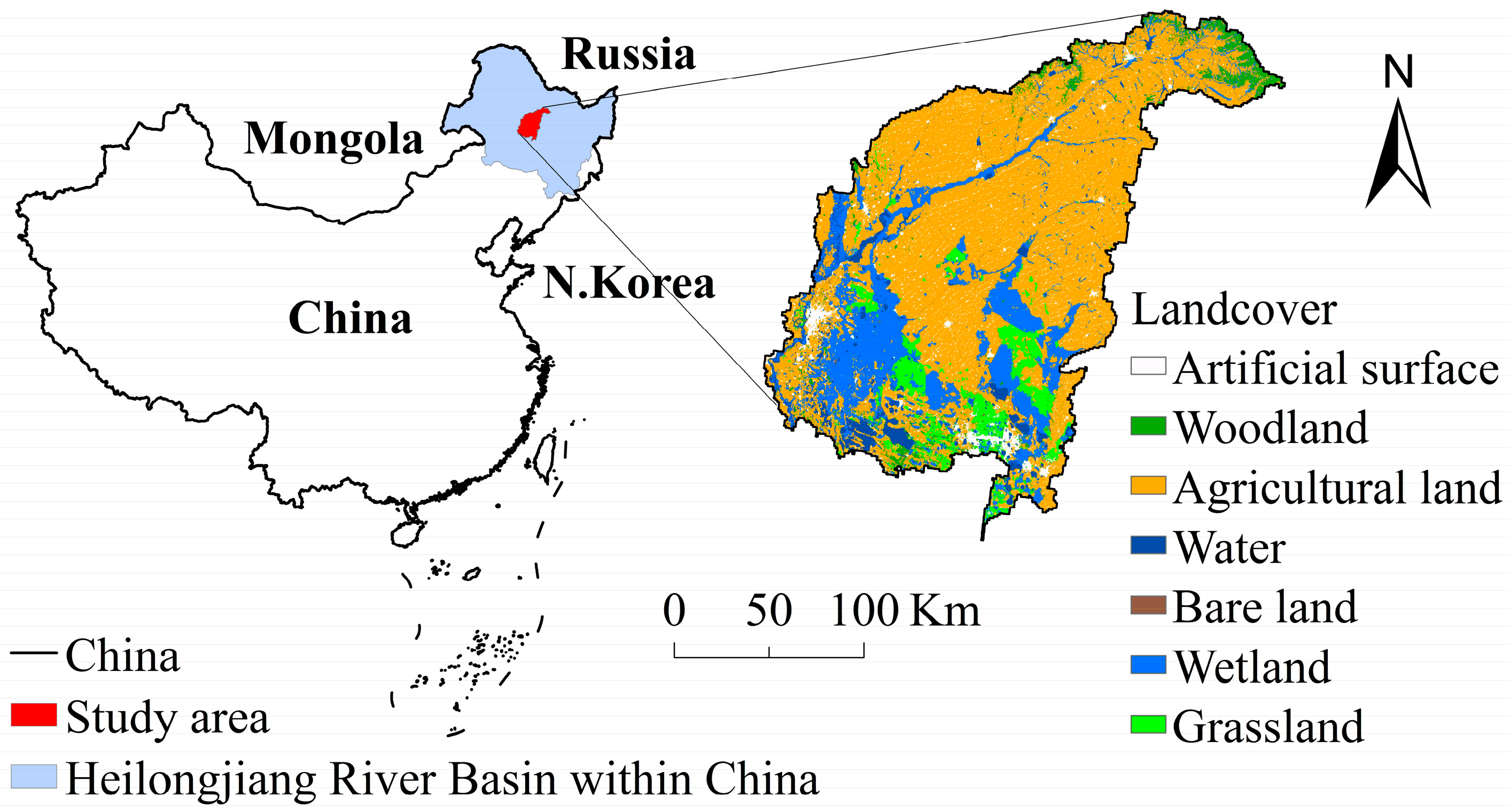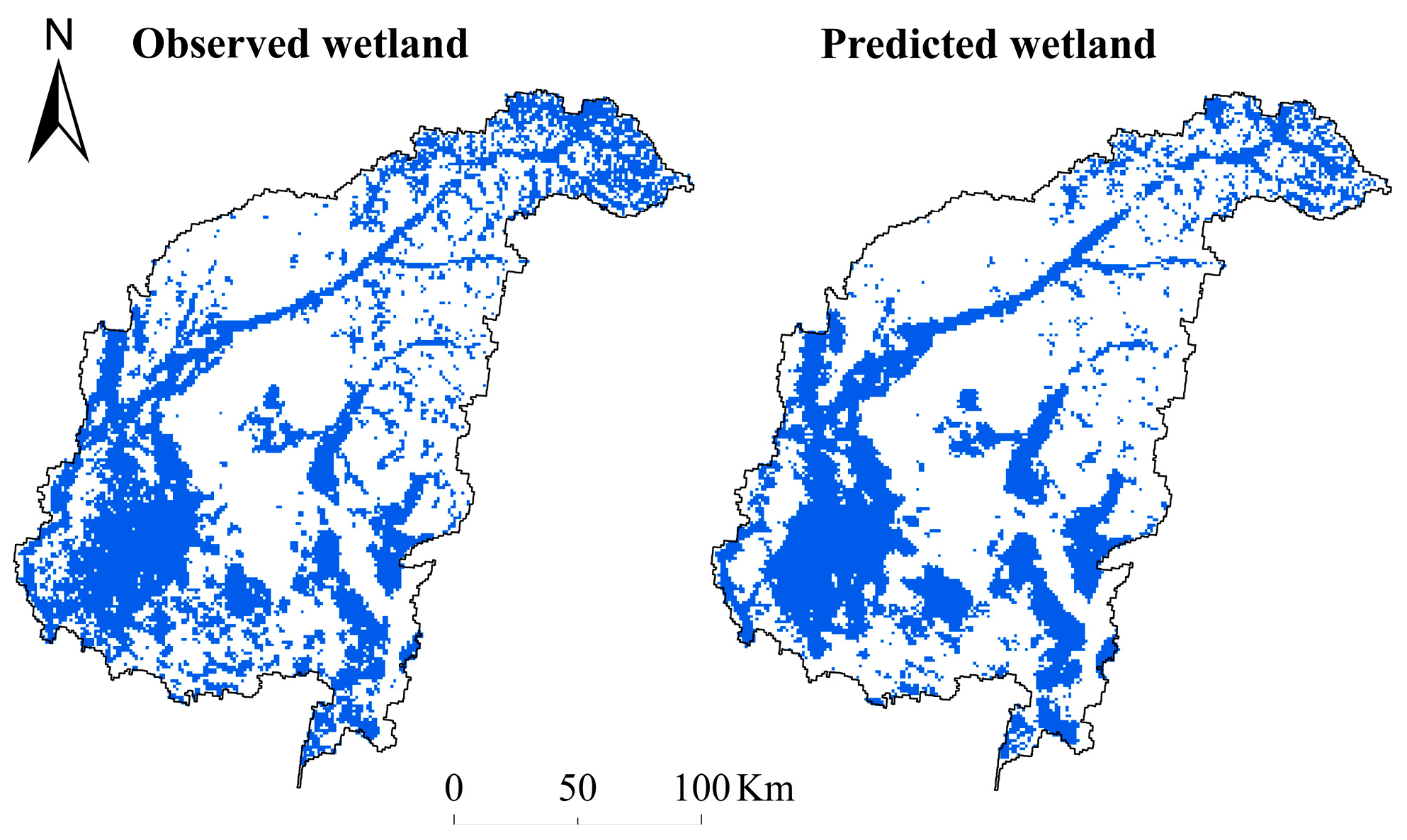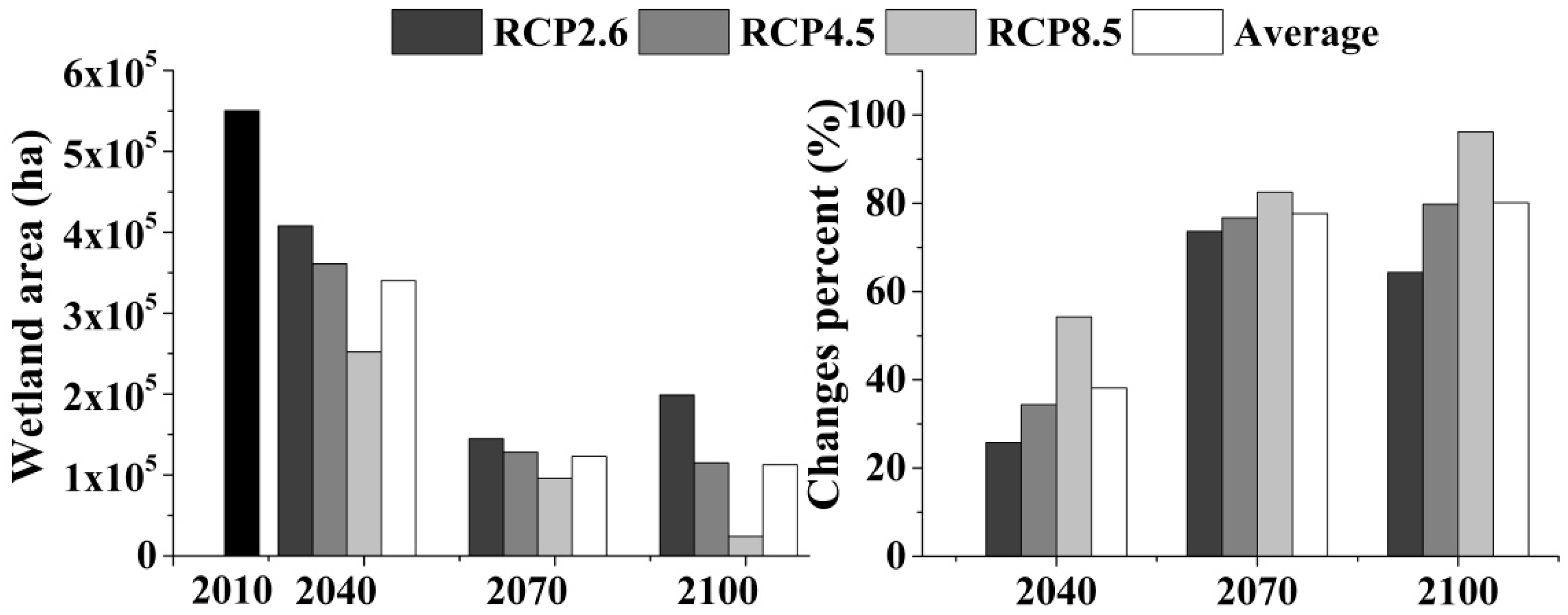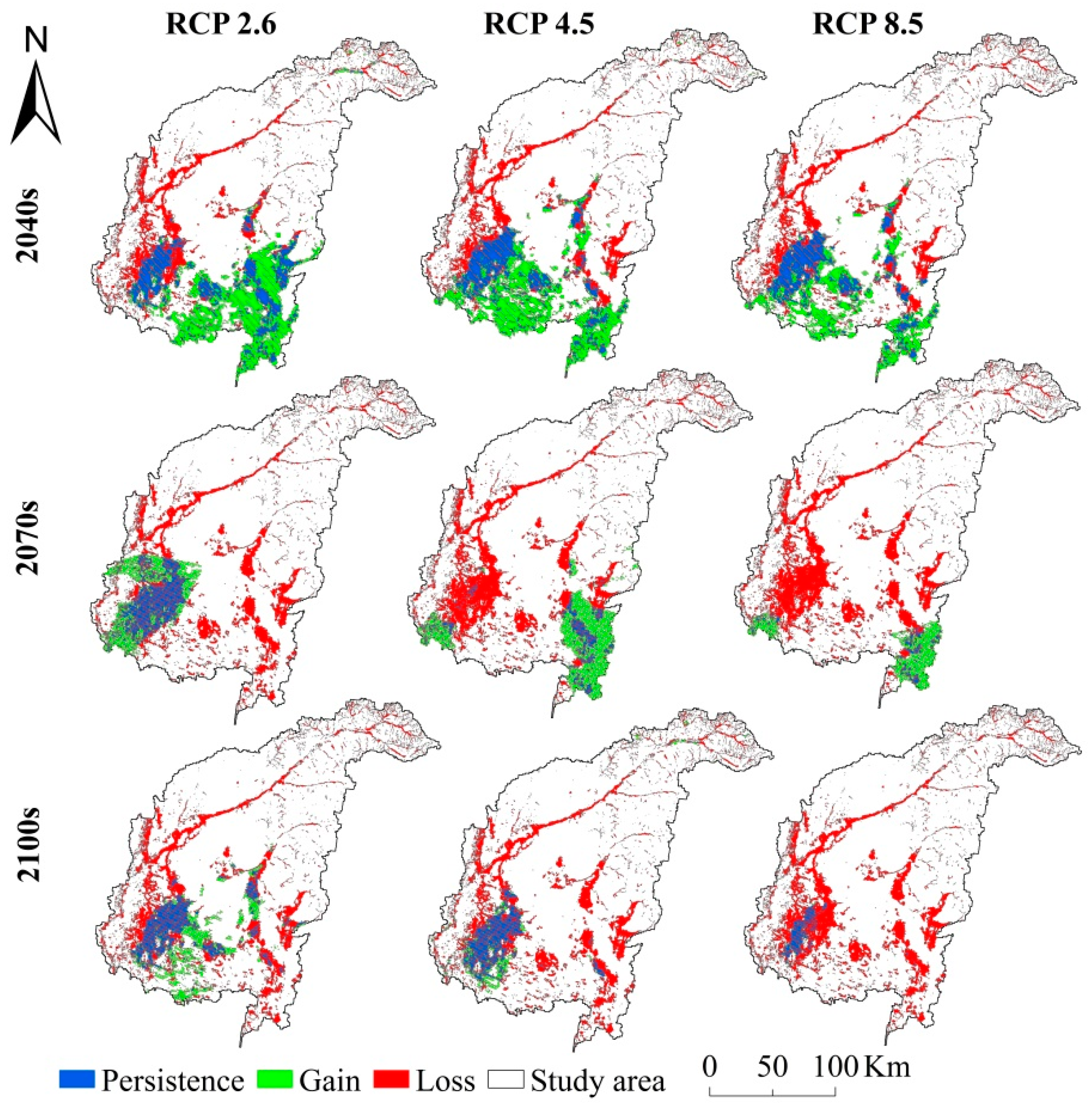Predicting Wetland Distribution Changes under Climate Change and Human Activities in a Mid- and High-Latitude Region
Abstract
:1. Introduction
2. Materials and Methods
2.1. Study Area
2.2. Historical Wetland Data
2.3. Climate Data and Climate Change Scenarios
2.4. Topographical Variables, Hydrological Variables, Climatic Variables, and Human Activity Variables
2.5. Model Performance, Validation, and Prediction
3. Results
3.1. Prediction Accuracy Assessment
3.2. Importance of Driving Variables
3.3. Future Wetland Distribution Changes
4. Discussion
4.1. The Relative Importance
4.2. Predicted Wetland Distribution Changes
4.3. Results Implications and Uncertainties
5. Conclusions
Acknowledgments
Author Contributions
Conflicts of Interest
References
- Song, Y.Y.; Song, C.C. An Introduction to National Key Research and Development Project: “Research on the Response of Wetland Ecosystems in Mid-high Latitudes to Climate Change” (No. 2016 YFA 0602300). Wetl. Sci. 2016, 14, 750–754. [Google Scholar]
- Nitta, T.; Yoshimura, K.; Abe-Ouchi, A. Impact of Arctic Wetlands on the Climate System: Model Sensitivity Simulations with the MIROC5 AGCM and a Snow-Fed Wetland Scheme. J. Hydrometeorol. 2017, 18, 2923–2936. [Google Scholar] [CrossRef]
- Junk, W.J.; An, S.; Finlayson, C.; Gopal, B.; Květ, J.; Mitchell, S.A.; Mitsch, W.J.; Robarts, R.D. Current state of knowledge regarding the world’s wetlands and their future under global climate change: A synthesis. Aquat. Sci. 2013, 75, 151–167. [Google Scholar] [CrossRef]
- Chen, H.; Zhao, Y.W. Evaluating the environmental flows of China’s Wolonghu wetland and land use changes using a hydrological model, a water balance model, and remote sensing. Ecol. Model. 2011, 222, 253–260. [Google Scholar] [CrossRef]
- Davidson, E.A.; Janssens, I.A. Temperature sensitivity of soil carbon decomposition and feedbacks to climate change. Nature 2006, 440, 165. [Google Scholar] [CrossRef] [PubMed]
- Arias, M.E.; Cochrane, T.A.; Kummu, M.; Lauri, H.; Holtgrieve, G.W.; Koponen, J.; Piman, T. Impacts of hydropower and climate change on drivers of ecological productivity of Southeast Asia’s most important wetland. Ecol. Model. 2014, 272, 252–263. [Google Scholar] [CrossRef]
- House, A.; Thompson, J.; Acreman, M. Projecting impacts of climate change on hydrological conditions and biotic responses in a chalk valley riparian wetland. J. Hydrol. 2016, 534, 178–192. [Google Scholar] [CrossRef]
- Helbig, M.; Chasmer, L.E.; Desai, A.R.; Kljun, N.; Quinton, W.L.; Sonnentag, O. Direct and indirect climate change effects on carbon dioxide fluxes in a thawing boreal forest–wetland landscape. Glob. Chang. Biol. 2017, 23, 3231–3248. [Google Scholar] [CrossRef] [PubMed]
- Bian, J.; Li, A.; Zhang, Z.; Zhao, W.; Lei, G.; Yin, G.; Jin, H.; Tan, J.; Huang, C. Monitoring fractional green vegetation cover dynamics over a seasonally inundated alpine wetland using dense time series HJ-1A/B constellation images and an adaptive endmember selection LSMM model. Remote. Sens. Environ. 2017, 197, 98–114. [Google Scholar] [CrossRef]
- Hartig, E.K.; Gornitz, V.; Kolker, A.; Mushacke, F.; Fallon, D. Anthropogenic and climate-change impacts on salt marshes of Jamaica Bay, New York City. Wetlands 2002, 22, 71–89. [Google Scholar] [CrossRef]
- Zhang, W.; Zhu, Y.B.; Jiang, J.G. Effect of the Urbanization of Wetlands on Microclimate: A Case Study of Xixi Wetland, Hangzhou, China. Sustainability 2016, 8, 885. [Google Scholar] [CrossRef]
- Gedan, K.B.; Silliman, B.R.; Bertness, M.D. Centuries of human-driven change in salt marsh ecosystems. Ann. Rev. Mar. Sci. 2009, 1, 117–141. [Google Scholar] [CrossRef] [PubMed]
- Syphard, A.D.; Garcia, M.W. Human-and beaver-induced wetland changes in the Chickahominy River watershed from 1953 to 1994. Wetlands 2001, 21, 342–353. [Google Scholar] [CrossRef]
- Abuodha, P.; Kairo, J. Human-induced stresses on mangrove swamps along the Kenyan coast. Hydrobiologia 2001, 458, 255–265. [Google Scholar] [CrossRef]
- Bai, J.; Lu, Q.; Wang, J.; Zhao, Q.; Ouyang, H.; Deng, W.; Li, A. Landscape pattern evolution processes of alpine wetlands and their driving factors in the Zoige plateau of China. J. Mt. Sci. 2013, 10, 54–67. [Google Scholar] [CrossRef]
- Nakicenovic, N.; Swart, R. Special Report on Emissions Scenarios; Cambridge University Press: Cambridge, UK, 2000; p. 612. [Google Scholar]
- Ekström, M.; Grose, M.R.; Whetton, P.H. An appraisal of downscaling methods used in climate change research. Wiley Interdis Clim. Chang. 2015, 6, 301–319. [Google Scholar] [CrossRef]
- Antoine, A.L.L.; Luc, A.; Jo De, R.; Laurent, L.; Christian, P.; Pascal, G. Investigating the respective impacts of groundwater exploitation and climate change on wetland extension over 150 years. J. Hydrol. 2014, 509, 367–378. [Google Scholar] [Green Version]
- Nicholls, R.J. Coastal flooding and wetland loss in the 21st century: Changes under the SRES climate and socio-economic scenarios. Glob. Environ. Chang. 2004, 14, 69–86. [Google Scholar] [CrossRef]
- Liu, H.J.; Bu, R.C.; Liu, J.T.; Leng, W.F.; Hu, Y.M.; Yang, L.B.; Liu, H.T. Predicting the wetland distributions under climate warming in the Great Xing’an Mountains, Northeastern China. Ecol. Res. 2011, 26, 605–613. [Google Scholar] [CrossRef]
- Zhang, X. Impacts of climate change on global agricultural land availability. Environ. Res. Lett. 2011, 6, 14014–14021. [Google Scholar] [CrossRef]
- Yoo, C.; Cho, E. Comparison of GCM Precipitation Predictions with Their RMSEs and Pattern Correlation Coefficients. Water 2018, 10, 28. [Google Scholar] [CrossRef]
- Jiang, X.; Xu, Z.; Liu, Z.; Liu, L. Evaluating the General Circulation Models over the Yangtze River Basin. Resour. Environ. Yangtze Basin 2011, 20, 51–58. [Google Scholar]
- Stocker, T.F.; Qin, D.; Plattner, G.K.; Tignor, M.; Allen, S.K.; Boschung, J.; Nauels, A.; Xia, Y.; Bex, V.; Midgley, P.M. IPCC 2013: Climate Change 2013: The Physical Science Basis. Contribution of Working Group I to the Fifth Assessment Report of the Intergovernmental Panel on Climate Change. Comput. Geom. 2013, 18, 95–123. [Google Scholar]
- Harris, R.M.B.; Grose, M.R.; Lee, G.; Bindoff, N.L.; Porfirio, L.L.; Fox-Hughes, P. Climate projections for ecologists. Wiley Interdiscip. Rev. Clim. Chang. 2014, 5, 621–637. [Google Scholar] [CrossRef]
- Grose, M.R.; Brown, J.N.; Narsey, S.; Brown, J.R.; Murphy, B.F.; Langlais, C.; Gupta, A.S.; Moise, A.F.; Irving, D.B. Assessment of the CMIP5 global climate model simulations of the western tropical Pacific climate system and comparison to CMIP3. Int. J. Clim. 2015, 34, 3382–3399. [Google Scholar] [CrossRef]
- Koneff, M.D.; Royle, J.A. Modeling wetland change along the United States Atlantic Coast. Ecol. Model. 2004, 177, 41–59. [Google Scholar] [CrossRef]
- He, W.; Bu, R.C.; Liu, H.J.; Xiong, Z.P.; Hu, Y.M. Prediction of the effects of climate change on the potential distribution of mire in northeastern China. Acta. Ecol. Sin. 2013, 33, 6314–6319. [Google Scholar] [CrossRef]
- Meng, H. Research on the Impact of Climate Change on the Marsh Distribution and Its Risk Assessment in the Sanjiang Plain Doctor; Northeast Institute of Geography and AGgroecology, Chinese Academy of Sciences: Changchun, China, 2016. [Google Scholar]
- Zhou, H.; Bu, R.C.; Hu, Y.M.; Yan, H.W.; Liu, H.J.; Leng, W.F.; Xu, S.L. Correlationsbetween potential distribution of wetlands in Great Hing’an Mountains and environmental variables. Chin. J. Ecol. 2007, 26, 1533–1541. [Google Scholar]
- Werner, B.A.; Johnson, W.C.; Guntenspergen, G.R. Evidence for 20th century climate warming and wetland drying in the North American Prairie Pothole Region. Ecol. Evol. 2013, 3, 3471–3482. [Google Scholar] [CrossRef] [PubMed]
- Jing, Y.Q.; Zhang, F.; Zhang, Y. Change and prediction of the land use/cover in Ebinur Lake Wetland Nature Reserve based on CA-Markov model. Chin. J. Appl. Ecol. 2016, 27, 3649–3658. [Google Scholar]
- Akin, A.; Berberoglu, S.; Erdogan, M.A.; Donmez, C. Modelling Land-use change dynamics in a mediterranean coastal wetland using Ca-markov chain analysis. Fresen. Environ. Bull. 2012, 21, 386–396. [Google Scholar]
- Liu, H.J.; Hu, Y.M.; Bu, R.C.; Liu, J.T.; Leng, W.F. Impacts of climate changes on the landscape patterns of potential mire distributions in northern Great Khing’an mountains. Adv. Water. Sci. 2009, 20, 105–110. [Google Scholar]
- Avis, C.A.; Weaver, A.J.; Meissner, K.J. Reduction in areal extent of high-latitude wetlands in response to permafrost thaw. Nat. Geosci. 2011, 4, 444–448. [Google Scholar] [CrossRef]
- Chan, J.C.-W.; Paelinckx, D. Evaluation of Random Forest and Adaboost tree-based ensemble classification and spectral band selection for ecotope mapping using airborne hyperspectral imagery. Remote Sens. Environ. 2008, 112, 2999–3011. [Google Scholar] [CrossRef]
- Man, W.D.; Yu, H.; Li, L.; Liu, M.Y.; Mao, D.H.; Ren, C.Y.; Wang, Z.M.; Jia, M.M.; Miao, Z.H.; Lu, C.Y.; et al. Spatial expansion and soil organic carbon storage changes of croplands in the Sanjiang plain, China. Sustainability 2017, 9, 563. [Google Scholar] [CrossRef]
- Man, W.D.; Wang, Z.M.; Liu, M.Y.; Lu, C.Y.; Jia, M.M.; Mao, D.H.; Ren, C.Y. Spatio-temporal dynamics analysis of cropland in Northeast China during 1990–2013 based on remote sensing. Trans. Chin. Soc. Agric. Eng. 2016, 32, 1–10. [Google Scholar]
- Ke, Y.H.; Quackenbush, L.J.; Im, J.H. Synergistic use of QuickBird multispectral imagery and LIDAR data for object-based forest species classification. Remote Sens. Environ. 2010, 114, 1141–1154. [Google Scholar] [CrossRef]
- Mao, D.H.; Wang, Z.M.; Luo, J.; Ren, C.Y.; Jia, M.M. Monitoring the Evolution of Wetland Ecosystem Pattern in Northeast China from 1990 to 2013 Based on Remote Sensing. J. Nat. Resour. 2016, 31, 1254–1263. [Google Scholar]
- Chu, Q.; Xu, Z.; Liu, W.; Liu, L. Assessment on 24 Global Climate Models in the CMIP5 over the Yangze River. Resour. Environ. Yangtze Basin 2015, 24, 81–89. [Google Scholar]
- Vuuren, D.P.; Stehfest, E.; Elzen, M.G.; Kram, T.; Vliet, J.; Deetman, S.; Isaac, M.; Goldewijk, K.K.; Hof, A.; Beltran, A.M. RCP2. 6: Exploring the possibility to keep global mean temperature increase below 2 C. Clim. Chang. 2011, 109, 95–116. [Google Scholar] [CrossRef]
- Thomson, A.M.; Calvin, K.V.; Smith, S.J.; Kyle, G.P.; Volke, A.; Patel, P.; Delgado-Arias, S.; Bond-Lamberty, B.; Wise, M.A.; Clarke, L.E. RCP4. 5: A pathway for stabilization of radiative forcing by 2100. Clim. Chang. 2011, 109, 77. [Google Scholar] [CrossRef]
- Riahi, K.; Rao, S.; Krey, V.; Cho, C.; Chirkov, V.; Fischer, G.; Kindermann, G.; Nakicenovic, N.; Rafaj, P. RCP 8.5—A scenario of comparatively high greenhouse gas emissions. Clim. Chang. 2011, 109, 33. [Google Scholar] [CrossRef]
- Flato, G.; Boer, G. Warming asymmetry in climate change simulations. Geophys. Res. Lett. 2001, 28, 195–198. [Google Scholar] [CrossRef]
- Kira, T. A New Classification of Climate in Eastern Asia as the Basis for Agricultural Geography; Horticultural Institute Kyoto University: Kyoto, Japan, 1945. [Google Scholar]
- Kira, T. On the altitudinal arrangement of climatic zones in Japan. Kanti-Nogaku 1948, 2, 143–173. [Google Scholar]
- Xu, W.D. The relation between the zonal distribution of types of vegetation and the climate in Northeast China. Acta Phytoecol. Geobot. Sin. (China) 1986, 10, 254–263. [Google Scholar]
- Holdridge, L.R. Determination of World Plant Formations from Simple Climatic Data. Science 1947, 105, 367–368. [Google Scholar] [CrossRef] [PubMed]
- Rosenzweig, M.L. Net primary productivity of terrestrial communities: Prediction from climatological data. Am. Nat. 1968, 102, 67–74. [Google Scholar] [CrossRef]
- Yue, T.X.; Liu, J.Y.; Jørgensen, S.E.; Gao, Z.Q.; Zhang, S.H.; Deng, X.Z. Changes of Holdridge life zone diversity in all of China over half a century. Ecol. Model. 2001, 144, 153–162. [Google Scholar] [CrossRef]
- Cui, L.J.; Gao, C.J.; Zhou, D.M.; Mu, L. Quantitative analysis of the driving forces causing declines in marsh wetland landscapes in the Honghe region, Northeast China, from 1975 to 2006. Environ. Earth. Sci. 2014, 71, 1357–1367. [Google Scholar] [CrossRef]
- Du, H.B.; He, H.S.; Wu, Z.F.; Wang, L.; Zong, S.; Liu, J. Human influences on regional temperature change–comparing adjacent plains of China and Russia. Int. J. Climatol. 2016, 37, 2913–2922. [Google Scholar] [CrossRef]
- Stocker, T. Climate Change 2013: The Physical Science Basis: Working Group I Contribution to the Fifth Assessment Report of the Intergovernmental Panel on Climate Change; Cambridge University Press: Oxford, UK, 2014. [Google Scholar]
- Vincenzi, S.; Zucchetta, M.; Franzoi, P.; Pellizzato, M.; Pranovi, F.; Leo, G.A.D.; Torricelli, P. Application of a Random Forest algorithm to predict spatial distribution of the potential yield of Ruditapes philippinarum in the Venice lagoon, Italy. Ecol. Model. 2011, 222, 1471–1478. [Google Scholar] [CrossRef]
- Breiman, L. Out-of-Bag Estimation; Technical Report; Statistics Department, University of California: Berkeley, CA, USA, 1996. [Google Scholar]
- Breiman, L. Random forests. Mach. Learn. 2001, 45, 5–32. [Google Scholar] [CrossRef]
- Wei, W.; Nie, Y.; Zhang, Z.; Hu, Y.; Yan, L.; Qi, D.; Li, X.; Wei, F. Hunting bamboo: Foraging patch selection and utilization by giant pandas and implications for conservation. Biol. Conserv. 2015, 186, 260–267. [Google Scholar] [CrossRef]
- Calle, M.L.; Urrea, V. Letter to the editor: Stability of Random Forest importance measures. Brief. Bioinform. 2011, 12, 86. [Google Scholar] [CrossRef] [PubMed]
- Crookston, N.L.; Rehfeldt, G.E.; Dixon, G.E.; Weiskittel, A.R. Addressing climate change in the forest vegetation simulator to assess impacts on landscape forest dynamics. For. Ecol. Manag. 2010, 260, 1198–1211. [Google Scholar] [CrossRef]
- Li, X. Using “random forest”for classification and regression. Chin. J. Appl. Entomol. 2013, 50, 4. [Google Scholar]
- Cassidy, A.P.; Deviney, F.A. Calculating feature importance in data streams with concept drift using Online Random Forest. In Proceedings of the IEEE International Conference on Big Data, Santa Clara, CA, USA, 29 October–1 November 2015; pp. 23–28. [Google Scholar]
- Hart, S.J.; Veblen, T.T.; Kulakowski, D. Do tree and stand-level attributes determine susceptibility of spruce-fir forests to spruce beetle outbreaks in the early 21st century? For. Ecol. Manag. 2014, 318, 44–53. [Google Scholar] [CrossRef]
- Wo, X.; Sun, Y. Study on dynamic change of land use and land cover in Zhalong wetland. J. Northeast Agric. Univ. 2010, 41, 56–60. [Google Scholar]
- Xu, J.; Dong, J. Landscape pattern change and its driving force of Nansihu Wetlands during 1987–2010. Wet. Sci. 2013, 11, 438–445. [Google Scholar]
- Lu, J.J.; He, W.S.; Tong, C.F.; Wang, W. Wetland Ecology; Higher Education Press: Beijing, China, 2006. [Google Scholar]
- Fuente, A.D.L.; Meruane, C. Spectral model for long-term computation of thermodynamics and potential evaporation in shallow wetlands. Water Resour. Res. 2017, 53. [Google Scholar] [CrossRef]
- Liao, X.; Inglett, P.W.; Inglett, K.S. Seasonal patterns of nitrogen cycling in subtropical short-hydroperiod wetlands: Effects of precipitation and restoration. Sci. Total. Environ. 2016, 556, 136–145. [Google Scholar] [CrossRef] [PubMed]
- Gerla, P.J. The relationship of water-table changes to the capillary fringe, evapotranspiration, and precipitation in intermittent wetlands. Wetlands 1992, 12, 91–98. [Google Scholar] [CrossRef]
- Song, K.S.; Wang, Z.M.; Zhang, B.; Jin, C.; Li, F.; Liu, H.J. Analysis of Cultivated Land Dynamics in the Past 50 Years in Sanjiang Plain and Its Driving Forces. J. Soil Water. Conserv. 2008, 4, 75–81. [Google Scholar]
- Wang, Z.M.; Song, K.S.; Liu, D.W.; Zhang, B.; Zhang, S.Q.; Li, F.; Ren, C.Y.; Jin, C.; Yang, T.; Zhang, C.H. Progress of Land Conversion from Marsh into Cropland in the Sanjiang Plain during 1954–2005. Wetl. Sci. 2009, 3, 208–217. [Google Scholar]
- Garris, H.W.; Mitchell, R.J.; Fraser, L.H.; Barrett, L.R. Forecasting climate change impacts on the distribution of wetland habitat in the Midwestern United states. Glob. Chang. Biol. 2015, 21, 766–776. [Google Scholar] [CrossRef] [PubMed]
- Merot, P.; Squividant, H.; Aurousseau, P.; Hefting, M.; Burt, T.; Maitre, V.; Kruk, M.; Butturini, A.; Thenail, C.; Viaud, V. Testing a climato-topographic index for predicting wetlands distribution along an European climate gradient. Ecol. Model. 2003, 163, 51–71. [Google Scholar] [CrossRef]
- Dong, X.L.; Grimm, N.B.; Ogle, K.; Franklin, J. Temporal variability in hydrology modifies the influence of geomorphology on wetland distribution along a desert stream. J. Ecol. 2016, 104, 18–30. [Google Scholar] [CrossRef]
- Sica, Y.V.; Quintana, R.D.; Radeloff, V.C.; Gavier-Pizarro, G.I. Wetland loss due to land use change in the Lower Paraná River Delta, Argentina. Sci. Total. Environ. 2016, 568, 967–978. [Google Scholar] [CrossRef] [PubMed]
- Mao, D.H.; Wang, Z.M.; Li, L.; Song, K.S.; Jia, M. Quantitative assessment of human-induced impacts on marshes in Northeast China from 2000 to 2011. Ecol. Eng. 2014, 68, 97–104. [Google Scholar] [CrossRef]
- Reese, G.C.; Skagen, S.K. Modeling nonbreeding distributions of shorebirds and waterfowl in response to climate change. Ecol. Evol. 2017, 7, 1497–1513. [Google Scholar] [CrossRef] [PubMed]
- Schleupner, C. GIS-based estimation of wetland conservation potentials in Europe. In Proceedings of the International Conference on Computational Science and Its Applications, Fukuoka, Japan, 23–26 March 2010; Springer: Berlin, Germany, 2010; pp. 193–209. [Google Scholar]
- Sofaer, H.R.; Skagen, S.K.; Barsugli, J.J.; Rashford, B.S.; Reese, G.C.; Hoeting, J.A.; Wood, A.W.; Noon, B.R. Projected wetland densities under climate change: Habitat loss but little geographic shift in conservation strategy. Ecol. Appl. 2016, 26, 1677–1692. [Google Scholar] [CrossRef] [PubMed]





| Year | Emission Scenarios | Annual Mean Temperature (°C) | Annual Mean Precipitation (mm) |
|---|---|---|---|
| 2010s | - | 2.62 | 485 |
| 2040s | RCP2.6 | 3.12 | 638 |
| RCP4.5 | 3.16 | 647 | |
| RCP8.5 | 3.31 | 650 | |
| 2070s | RCP2.6 | 3.44 | 655 |
| RCP4.5 | 3.70 | 660 | |
| RCP8.5 | 4.31 | 661 | |
| 2100s | RCP2.6 | 3.52 | 659 |
| RCP4.5 | 4.07 | 672 | |
| RCP8.5 | 5.29 | 685 |
| Factor | Variable | Unit | Importance Score (%) |
|---|---|---|---|
| Climate | Annual biological temperature | °C | 10.34 |
| Potential evapotranspiration ratio | °C/mm | 7.94 | |
| Annual mean temperature | °C | 9.09 | |
| Humidity index | mm/°C | 7.42 | |
| Annual mean precipitation | mm | 10.57 | |
| Coldness index | °C | 10.83 | |
| Warmness index | °C | 11.47 | |
| Average | 9.67 | ||
| Topography | Elevation | m | 3.45 |
| Slope | ° | 0.89 | |
| Classification of aspect | 0.90 | ||
| Average | 1.75 | ||
| Hydrology | Distance to water body | m | 11.15 |
| Dry farmland area proportion | 5.77 | ||
| Paddy field area proportion | 9.10 | ||
| Human activities | Agricultural population proportion | 13.06 | |
| Distance to roads | m | 8.58 | |
| Average | 9.13 |
© 2018 by the authors. Licensee MDPI, Basel, Switzerland. This article is an open access article distributed under the terms and conditions of the Creative Commons Attribution (CC BY) license (http://creativecommons.org/licenses/by/4.0/).
Share and Cite
Zhao, D.; He, H.S.; Wang, W.J.; Wang, L.; Du, H.; Liu, K.; Zong, S. Predicting Wetland Distribution Changes under Climate Change and Human Activities in a Mid- and High-Latitude Region. Sustainability 2018, 10, 863. https://doi.org/10.3390/su10030863
Zhao D, He HS, Wang WJ, Wang L, Du H, Liu K, Zong S. Predicting Wetland Distribution Changes under Climate Change and Human Activities in a Mid- and High-Latitude Region. Sustainability. 2018; 10(3):863. https://doi.org/10.3390/su10030863
Chicago/Turabian StyleZhao, Dandan, Hong S. He, Wen J. Wang, Lei Wang, Haibo Du, Kai Liu, and Shengwei Zong. 2018. "Predicting Wetland Distribution Changes under Climate Change and Human Activities in a Mid- and High-Latitude Region" Sustainability 10, no. 3: 863. https://doi.org/10.3390/su10030863




